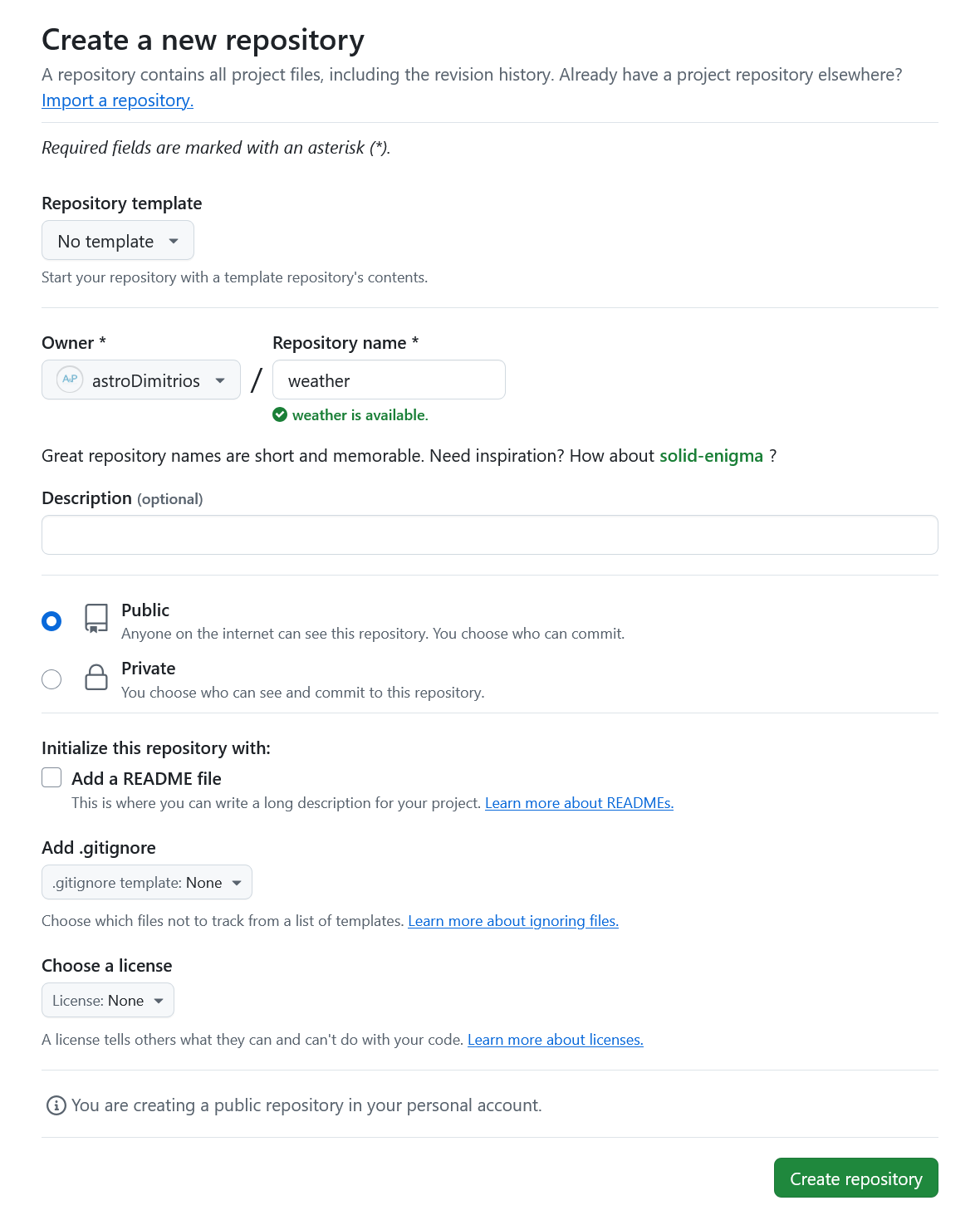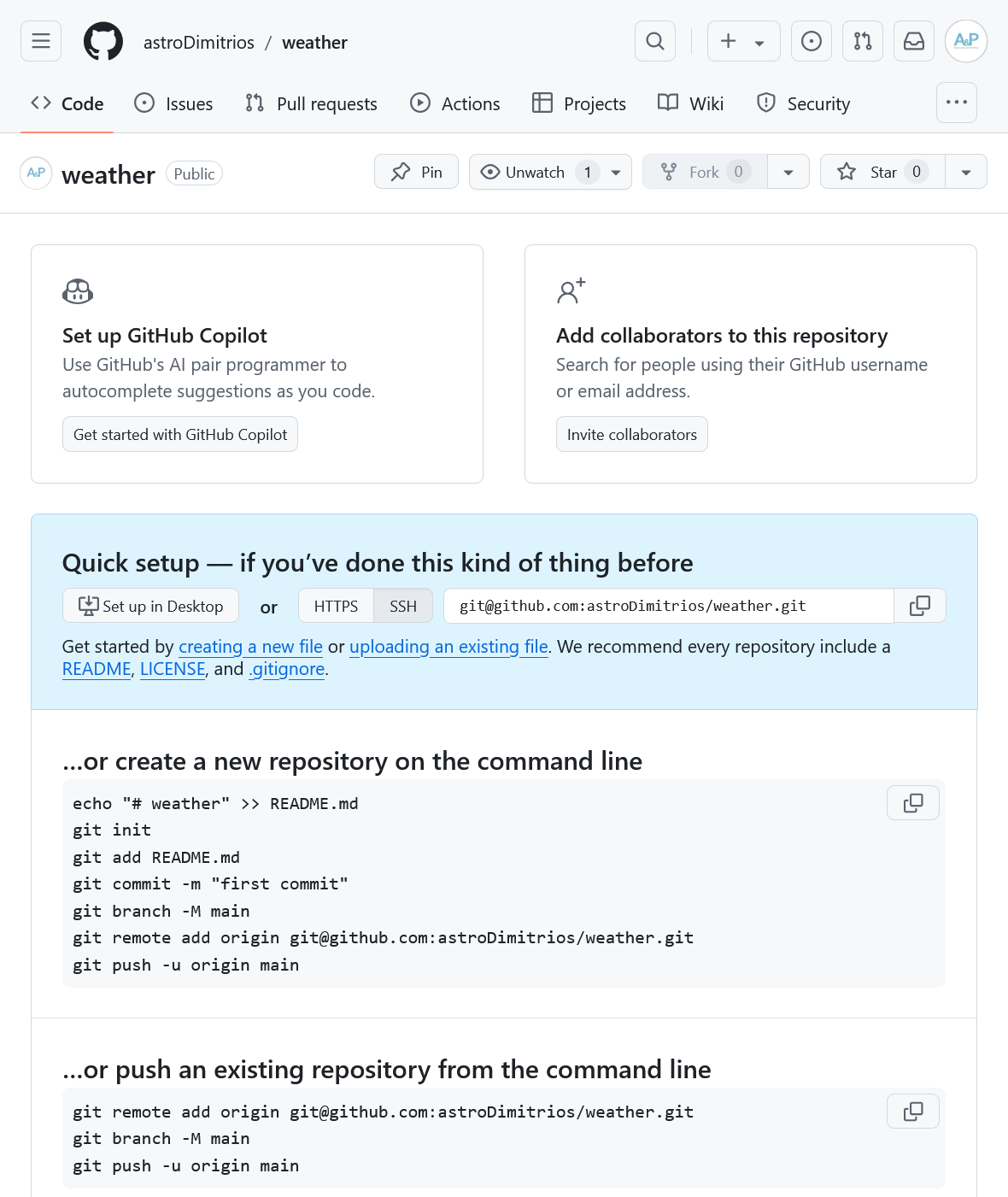Remotes in GitHub
Last updated on 2025-02-25 | Edit this page
Estimated time: 45 minutes
Overview
Questions
- How do I share my changes with others on the web?
Objectives
- Explain what remote repositories are and why they are useful.
- Push to or pull from a remote repository.
Version control really comes into its own when we begin to collaborate with other people. We already have most of the machinery we need to do this; the only thing missing is to copy changes from one repository to another.
Systems like Git allow us to move work between any two repositories. In practice, though, it’s easiest to use one copy as a central hub, and to keep it on the web rather than on someone’s laptop. Most programmers use hosting services like GitHub, Bitbucket or GitLab to hold those main copies; we’ll explore the pros and cons of this in a later episode.
Let’s now share the changes we’ve made to our current project with the world. To this end we are going to create a remote repository that will be linked to our local repository.
1. Create a remote repository
Log in to GitHub, then click on the
icon in the top right corner to create a new repository called
weather:

Name your repository “weather” and then click “Create Repository”.
Note: Since this repository will be connected to a local repository, it needs to be empty. Leave “Initialize this repository with a README” unchecked, and keep “None” as options for both “Add .gitignore” and “Add a license.” See the “GitHub License and README files” exercise below for a full explanation of why the repository needs to be empty.

Here we have chosen to make our repository public. The visibility of your repository depends on which option you choose:
- Private: only you
- Internal (organisations only): read permissions to anyone in the organisation
- Public: read permissions to anyone
Some organisations will restrict the creation of public repositories so you may find their default is internal. If your project deals with sensitive material then create a private repository.
As soon as the repository is created, GitHub displays a page with a URL and some information on how to configure your local repository. Ignore the suggested commands for now as we will run these later.

This effectively does the following on GitHub’s servers:
If you remember back to the earlier episode where we added and committed our
earlier work on forecast.md, we had a diagram of the local
repository which looked like this:
Now that we have two repositories, we need a diagram like this:
Note that our local repository still contains our earlier work on
forecast.md, but the remote repository on GitHub appears
empty as it doesn’t contain any files yet.
2. Connect local to remote repository
Now we connect the two repositories. We do this by making the GitHub repository a remote for the local repository. The home page of the repository on GitHub includes the URL string we need to identify it:

Click on the ‘SSH’ link to change the protocol from HTTPS to SSH.
HTTPS vs. SSH
We use SSH here because, while it requires some additional configuration, it is a security protocol widely used by many applications. The steps below describe SSH at a minimum level for GitHub.
If you use a Personal Access Token (PAT) to connect to GitHub you should select ‘HTTPS’ not ‘SSH’.
We recommend you move to using SSH Keys instead of a PAT. The setup instructions show you how to set up an SSH key.
If you choose to continue using your PAT, in the rest of the material any SSH links such as:
should be converted to the HTTPS form like this:
Copy that URL from the browser, go into the local
weather repository, and run this command:
Make sure to use the URL for your repository: the only difference
should be your username instead of mo-eormerod.
origin is a local name used to refer to the remote
repository. It could be called anything, but origin is a
convention that is often used by default in Git and GitHub, so it’s
helpful to stick with this unless there’s a reason not to.
We can check that the command has worked by running
git remote -v:
OUTPUT
origin git@github.com:mo-eormerod/weather.git (fetch)
origin git@github.com:mo-eormerod/weather.git (push)We’ll discuss remotes in more detail in the next episode, while talking about how they might be used for collaboration.
3. Push local changes to a remote
Now that authentication is setup, we can return to the local
repository. Ensure you are on the main branch:
This command will push our main branch on our local repository to the repository on GitHub:
OUTPUT
fatal: The current branch main has no upstream branch.
To push the current branch and set the remote as upstream, use
git push --set-upstream origin main
Git is telling us it doesn’t know what branch we want to push our
local main branch to on GitHub. We can tell Git this by
setting the upstream origin branch to also be named
main.
If you entered a passphrase when creating an shh key you will be prompted for it.
OUTPUT
Enumerating objects: 16, done.
Counting objects: 100% (16/16), done.
Delta compression using up to 4 threads
Compressing objects: 100% (13/13), done.
Writing objects: 100% (16/16), 1.69 KiB | 216.00 KiB/s, done.
Total 16 (delta 1), reused 0 (delta 0), pack-reused 0
remote: Resolving deltas: 100% (1/1), done.
To github.com:mo-eormerod/weather.git
* [new branch] main -> main
branch 'main' set up to track 'origin/main'.Proxy
If the network you are connected to uses a proxy, there is a chance that your last command failed with “Could not resolve hostname” as the error message. To solve this issue, you need to tell Git about the proxy:
BASH
$ git config --global http.proxy http://user:password@proxy.url
$ git config --global https.proxy https://user:password@proxy.urlWhen you connect to another network that doesn’t use a proxy, you will need to tell Git to disable the proxy using:
Password Managers
If your operating system has a password manager configured,
git push will try to use it when it needs your username and
password. For example, this is the default behavior for Git Bash on
Windows. If you want to type your username and password at the terminal
instead of using a password manager, type:
in the terminal, before you run git push. Despite the
name, Git
uses SSH_ASKPASS for all credential entry, so you may
want to unset SSH_ASKPASS whether you are using Git via SSH
or https.
You may also want to add unset SSH_ASKPASS at the end of
your ~/.bashrc to make Git default to using the terminal
for usernames and passwords.
Our local and remote repositories are now in this state:
The ‘-u’ Flag
You may see a -u option used with git push
in some documentation. This option is synonymous with the
--set-upstream-to option for the git branch
command, and is used to associate the current branch with a remote
branch so that the git push command can be used without any
arguments. To do this, simply use git push -u origin main
once the remote has been set up.
Here, we are telling Git to push the branch to the origin (GitHub)
repositories main branch.
We can pull changes from the remote repository to the local one as well:
OUTPUT
Already up-to-date.Pulling has no effect in this case because the two repositories are already synchronized. If someone else had pushed some changes to the repository on GitHub, though, this command would download them to our local repository.
GitHub GUI
Browse to your weather repository on GitHub. Under the
Code tab, find and click on the text that says “XX commits” (where “XX”
is some number). Hover over, and click on, the three buttons to the
right of each commit. What information can you gather/explore from these
buttons? How would you get that same information in the shell?
The left-most button (with the picture of a clipboard) copies the
full identifier of the commit to the clipboard. In the shell,
git log will show you the full commit identifier for each
commit.
When you click on the middle button, you’ll see all of the changes
that were made in that particular commit. Green shaded lines indicate
additions and red ones removals. In the shell we can do the same thing
with git diff. In particular,
git diff ID1..ID2 where ID1 and ID2 are commit identifiers
(e.g. git diff a3bf1e5..041e637) will show the differences
between those two commits.
The right-most button lets you view all of the files in the
repository at the time of that commit. To do this in the shell, we’d
need to checkout the repository at that particular time. We can do this
with git checkout ID where ID is the identifier of the
commit we want to look at. If we do this, we need to remember to put the
repository back to the right state afterwards!
Uploading files directly in GitHub browser
Github also allows you to skip the command line and upload files directly to your repository without having to leave the browser. There are two options. First you can click the “Upload files” button in the toolbar at the top of the file tree. Or, you can drag and drop files from your desktop onto the file tree. You can read more about this on this GitHub page.
GitHub Timestamp
Create a remote repository on GitHub. Push the contents of your local repository to the remote. Make changes to your local repository and push these changes. Go to the repo you just created on GitHub and check the timestamps of the files. How does GitHub record times, and why?
GitHub displays timestamps in a human readable relative format (i.e. “22 hours ago” or “three weeks ago”). However, if you hover over the timestamp, you can see the exact time at which the last change to the file occurred.
Push vs. Commit
In this episode, we introduced the “git push” command. How is “git push” different from “git commit”?
When we push changes, we’re interacting with a remote repository to update it with the changes we’ve made locally (often this corresponds to sharing the changes we’ve made with others). Commit only updates your local repository.
GitHub License and README files
In this episode we learned about creating a remote repository on GitHub, but when you initialized your GitHub repo, you didn’t add a README.md or a license file. If you had, what do you think would have happened when you tried to link your local and remote repositories?
In this case, we’d see a merge conflict due to unrelated histories. When GitHub creates a README.md file, it performs a commit in the remote repository. When you try to pull the remote repository to your local repository, Git detects that they have histories that do not share a common origin and refuses to merge.
OUTPUT
warning: no common commits
remote: Enumerating objects: 3, done.
remote: Counting objects: 100% (3/3), done.
remote: Total 3 (delta 0), reused 0 (delta 0), pack-reused 0
Unpacking objects: 100% (3/3), done.
From https://github.com/mo-eormerod/weather
* branch main -> FETCH_HEAD
* [new branch] main -> origin/main
fatal: refusing to merge unrelated historiesYou can force git to merge the two repositories with the option
--allow-unrelated-histories. Be careful when you use this
option and carefully examine the contents of local and remote
repositories before merging.
OUTPUT
From https://github.com/mo-eormerod/weather
* branch main -> FETCH_HEAD
Merge made by the 'recursive' strategy.
README.md | 1 +
1 file changed, 1 insertion(+)
create mode 100644 README.mdKey Points
- A local Git repository can be connected to one or more remote repositories.
- Use the SSH protocol to connect to remote repositories.
-
git pushcopies changes from a local repository to a remote repository. -
git pullcopies changes from a remote repository to a local repository.
